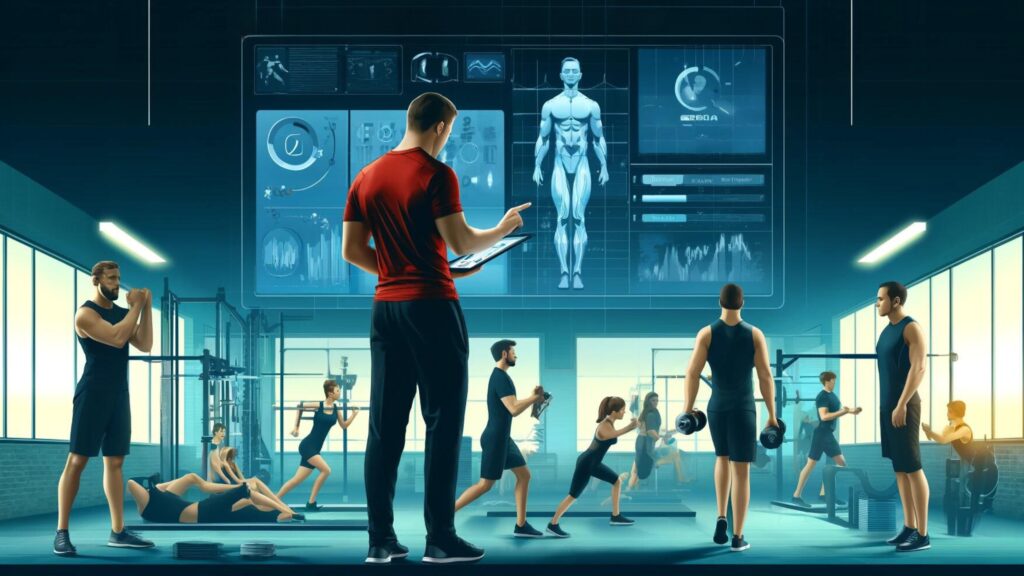Fitness Mastery reveals a world in which elite trainers keep their most effective secrets. This blog delves deeply into the five secret techniques that turn beginners into seasoned athletes. Anyone willing to push their limits now has access to these insights, previously reserved for the upper echelons of the fitness industry. Whether you want to break down personal barriers or sculpt an enviable physique, understanding these hidden strategies could change the way you approach fitness and lead to unprecedented results. Prepare to go beyond traditional workouts as we reveal what truly drives success behind closed gym doors.

Introduction to Fitness Mastery
The concept of fitness mastery is explained
Fitness mastery goes beyond traditional workout routines, incorporating an advanced approach that combines scientific insights with tailored strategies to improve physical performance. This concept is about mastering the art and science of fitness, transforming an individual’s capabilities from simple exercise to a finely tuned orchestration of body dynamics.
Why Fitness Mastery is Important for Serious Athletes
Fitness Mastery is not only beneficial to serious athletes; it is essential. It allows them to outperform their competitors while significantly reducing the risk of injury. Mastery ensures that their training is both efficient and effective, with a focus on optimal performance outcomes rather than simply participating.
Understanding the Effect of Expert Secrets on Fitness Mastery is crucial
Expert fitness secrets include cutting-edge techniques and previously unknown insights that provide a competitive advantage. These secrets can dramatically improve an athlete’s performance by fine-tuning every aspect of their regimen, from diet to recovery processes.
Decoding the Elite Fitness Mentality
The elite fitness mentality is defined by resilience, discipline, and a never-ending pursuit of excellence. This mindset is essential for anyone striving for fitness mastery because it motivates the consistent effort and unwavering focus required to achieve and maintain peak physical condition.
The Journey to Fitness Mastery: What It Takes
embarking on the journey to fitness Mastery requires more than just regular training. It necessitates a complete overhaul of one’s lifestyle, including rigorous training regimens, precise nutrition plans, and advanced mental conditioning techniques. Each component is critical to developing the exceptional athletic prowess that mastery requires.
The importance of dedication in developing fitness mastery
Dedication is the foundation of fitness mastery. It is an unwavering commitment to daily discipline, whether one is motivated or not. This dedication guarantees the continuation of training, the improvement of skills, and the gradual achievement of performance targets.
Comparing Standard Fitness Regimes and Fitness Mastery Techniques
Standard fitness regimens frequently focus on overall health and moderate physical improvement. Fitness mastery techniques, on the other hand, are meticulously designed to maximize physical abilities and push the limits of what the body is capable of, using advanced training methodologies and scientific principles.
The Psychological Aspects of Fitness Mastery
The psychological aspects of fitness mastery include building mental toughness, improving focus, and cultivating a growth mindset. These psychological strategies are essential for overcoming the inevitable challenges and plateaus in training, allowing athletes to perform under pressure while maintaining progress.
Tools and equipment are required for fitness mastery
Achieving fitness mastery frequently necessitates more than basic gym equipment. Advanced tools, such as high-altitude training masks, mobility devices, and biomechanical feedback instruments, may be required. These tools help to refine technique, increase strength and endurance, and provide detailed feedback for ongoing improvement.
How Fitness Mastery Takes Your Workout from Routine to Exceptional
Fitness mastery elevates each workout from a routine exercise session to a meticulously planned component of a larger goal. Each workout is purpose-driven and designed to challenge both the body and the mind, ensuring that each session contributes to the overall goal of improved performance and physical excellence. This transformation is what distinguishes mastery as both a journey and a goal in the fitness world.
- Introduction to Fitness Mastery
- The concept of fitness mastery is explained
- Why Fitness Mastery is Important for Serious Athletes
- Understanding the Effect of Expert Secrets on Fitness Mastery is crucial
- Decoding the Elite Fitness Mentality
- The Journey to Fitness Mastery: What It Takes
- The importance of dedication in developing fitness mastery
- Comparing Standard Fitness Regimes and Fitness Mastery Techniques
- The Psychological Aspects of Fitness Mastery
- Tools and equipment are required for fitness mastery
- How Fitness Mastery Takes Your Workout from Routine to Exceptional
- The first secret: customized training regimes
- This is an introduction to customized training for fitness mastery
- How Customized Programs Lead You to Fitness Mastery
- Analyzing Your Body Type for Fitness Mastery Customization
- The role that genetics plays in mastering fitness
- Case Studies: Customized Fitness Plans' Success Stories
- Adjusting your fitness goals for maximum benefit
- Advanced tracking to monitor fitness mastery progress
- Putting New Fitness Mastery Techniques into Practice
- Assessing progress and improving custom plans
- Expert Tips for Maintaining Motivation in Customized Training
- The second secret is precision nutrition
- Principles of Nutrition for Fitness Mastery
- Macro and micronutrient management for Elite Fitness
- The science behind supplements for mastering fitness
- Meal Planning Strategies for Aspiring Fitness Masters
- The timing of meals and their impact on performance
- Fitness Mastery helps you dispel diet myths
- How can you consult with a nutritionist about your fitness goals?
- Real-Life Diet Examples from Fitness Pros
- Fitness Mastery: Balancing Diet and Exercise
- Precision Nutrition's Long-Term Benefits
- The Third Secret: Advanced Recovery Techniques
- Why Recovery is Critical to Fitness Mastery
- Top athletes use cutting-edge recovery tools
- The Science of Active Recovery
- Innovative Sleep Strategies for Improved Recovery
- Hydration plays an underappreciated role in recovery
- The procedure begins with a few minutes
- Contrast Therapy: When and How to Use
- Recovery Diets: What to Eat After Workouts
- Monitor Your Recovery: Signs You're Doing It Right
- Psychological aspects of recovery include fitness mastery
- The fourth secret: mental conditioning
- Mental Toughness and Fitness Mastery
- Visualization Techniques to Achieve Fitness Goals
- Developing Resilience: Overcoming Setbacks in Training
- The role of a sports psychologist in fitness mastery is significant
- Cognitive-behavioral approaches to improving performance
- Breathing Techniques to Improve Your Mental and Physical Health
- Routine and Ritual: Developing a Winner's Mindset
- The Effect of Stress on Performance and How to Manage It
- Keep Focus: Concentration Exercises for Athletes
- The Relationship Between Mental Health and Peak Physical Performance
- The Fifth Secret: Community and Coaching
- The impact of a strong support network on fitness mastery
- Choosing the Right Coach for Your Fitness Goals
- Group Dynamics in Fitness Mastery: Learn from Peers
- The role of mentorship in accelerating progress is significant
- Building a Culture of Success in Fitness Communities
- Feedback Loops: Constructive Criticism's Value
- Competitive advantage: training with the best
- The influence of role models on aspiring fitness masters is significant
- Networking in Fitness Circles for Opportunities
- Celebrating achievements and milestones in fitness mastery
- Professional Step-by-Step Guide: "Fitness Mastery: 5 Secrets Experts Do Not Share"
- FAQs for "Fitness Mastery: Five Secrets Experts Don't Share."
- Conclusion

The first secret: customized training regimes
This is an introduction to customized training for fitness mastery
Customized training is a key component of fitness mastery, tailored to individual goals, abilities, and limitations. This personalized approach ensures that every workout and every rep are targeted toward specific goals, maximizing efficiency and effectiveness. It is about recognizing that no two bodies are alike, and neither should their training plans.
How Customized Programs Lead You to Fitness Mastery
By adapting to each person’s unique physical responses, customized programs push people to their maximum performance. Such programs dynamically adapt to progress and plateaus, focusing on areas for improvement while enhancing those already mastered. This personalization not only maximizes physical gains but also keeps training mentally stimulating.
Analyzing Your Body Type for Fitness Mastery Customization
Understanding your body type is essential for tailoring your fitness regimen. Ectomorphs, mesomorphs, and endomorphs all respond differently to different types of exercise and diet. Analyzing and recognizing these differences is the first step toward developing a truly personalized fitness plan that can effectively address individual physiological needs.
The role that genetics plays in mastering fitness
Genetics influences how we respond to various training methods and regimens. Some people may be genetically predisposed to quickly gain muscle, whereas others may prefer endurance activities. Recognizing these genetic predispositions can have a significant impact on the customization of your fitness program, directing you toward exercises that produce the best results.
Case Studies: Customized Fitness Plans’ Success Stories
Real-world case studies demonstrate the profound impact of customized fitness plans. From athletes who have broken personal records to people who have transformed their bodies despite genetic odds, these stories inspire and demonstrate the practical benefits of personalized fitness strategies.
Adjusting your fitness goals for maximum benefit
As you progress through your fitness journey, your body’s needs and capabilities change. Periodic adjustments to your fitness goals based on ongoing assessments ensure that your regimen remains both challenging and achievable. This dynamic tweaking prevents plateaus and promotes long-term progress.
Advanced tracking to monitor fitness mastery progress
Advanced tracking technologies and methodologies can provide valuable insights into your fitness journey. Wearable devices that monitor physiological responses, as well as apps that track performance metrics, are invaluable tools for fine-tuning your training regimen and ensuring that you are on the fast track to fitness mastery.
Putting New Fitness Mastery Techniques into Practice
As the physical fitness landscape changes, so should your training regimen. Incorporating new and proven techniques not only keeps the routine from becoming stale, but it also challenges the body in new ways, sparking further improvements and keeping the path to mastery exciting and effective.
Assessing progress and improving custom plans
Continuous evaluation is essential for a successful, customized training regimen. This process entails determining whether current practices are effective or if they require improvement. Regular feedback loops help to refine techniques, ensuring that each phase of training is optimized for the best results.
Expert Tips for Maintaining Motivation in Customized Training
Maintaining motivation can be difficult, especially with lofty long-term goals. To keep the spirit up, experts advise setting small, attainable goals, celebrating these accomplishments, and varying the conditioning of the training environment. Furthermore, reminding yourself of the ultimate goal and progress made can rekindle your dedication and enthusiasm for the journey.

The second secret is precision nutrition
Principles of Nutrition for Fitness Mastery
Precision nutrition is the foundation of any successful fitness program, representing a balance of quality and quantity in dietary intake. This comprehensive approach not only fuels the body optimally for training and recovery, but it also customizes nutrient intake based on individual metabolic rates and fitness goals. Understanding the fundamentals of macronutrients (proteins, fats, and carbohydrates) and micronutrients (vitamins and minerals) is critical for designing a diet that promotes physical performance and health.
Macro and micronutrient management for Elite Fitness
To perform at their best, elite athletes must carefully manage their macro- and micronutrient intake. Macronutrients provide the energy and building blocks required for muscle repair and growth, whereas micronutrients promote overall bodily function and recovery. By perfectly balancing these elements to meet the rigorous demands of high-level physical activity, effective nutrient management improves both performance and recovery.
The science behind supplements for mastering fitness
Supplements can help you achieve fitness mastery, fill nutritional gaps, and improve performance. However, knowing which supplements are beneficial and how they interact with the body is critical. This segment delves into the science behind popular supplements like protein powders, creatine, BCAAs, and multivitamins, as well as their strategic application in fitness regimens.
Meal Planning Strategies for Aspiring Fitness Masters
Strategic meal planning is essential for those looking to improve their physical fitness. This entails not only selecting the appropriate foods but also timing their consumption to maximize the benefits. Tips include meal planning to meet macronutrient needs, incorporating variety to meet micronutrient requirements, and preparing meals ahead of time to ensure consistency in diet adherence.
The timing of meals and their impact on performance
The timing of nutrient intake is just as important as the nutrients themselves, especially during training sessions. Consuming the proper carbohydrate and protein balance before and after a workout can have a significant impact on muscle recovery and energy. This section discusses how strategic meal timing can improve workout performance and recovery, accelerating progress toward fitness goals.
Fitness Mastery helps you dispel diet myths
Diet myths can derail even the most committed athletes in the fitness industry. This section addresses common misconceptions, such as the overemphasis on carbohydrates as the enemy, fat consumption misunderstandings, and protein myths, providing scientifically supported information to help readers develop effective nutritional strategies.
How can you consult with a nutritionist about your fitness goals?
Consulting a professional nutritionist can help you tailor your dietary plan to your specific fitness goals. This section informs readers about what to expect during a consultation, how to prepare, and what questions to ask to make the most of the experience. It emphasizes the importance of developing a personalized eating plan that complements an individual’s training regimen and fitness goals.
Real-Life Diet Examples from Fitness Pros
Learning about fitness professionals’ diets can provide useful insights and inspiration. This segment includes detailed examples of daily eating plans from various fitness experts, demonstrating how balanced and strategic nutrition fuels rigorous training, aids recovery, and improves performance.
Fitness Mastery: Balancing Diet and Exercise
Fitness mastery necessitates a mutually beneficial relationship between diet and exercise. This section delves into how to balance nutritional intake with various types of training to optimize body composition, increase energy levels, and improve overall health, allowing readers to develop a consistent fitness plan that promotes long-term progress.
Precision Nutrition’s Long-Term Benefits
Precision nutrition is about not only improving current performance but also investing in long-term health. This final section discusses the long-term benefits of a well-managed diet, such as improved metabolic health, longevity, a higher quality of life, and sustained physical performance, making a compelling case for incorporating meticulous nutritional habits into a lifelong commitment to fitness mastery.

The Third Secret: Advanced Recovery Techniques
Why Recovery is Critical to Fitness Mastery
Recovery is more than just a break from training; it’s an essential component of fitness mastery. It allows the body to repair, rebuild, and strengthen itself, which is critical for long-term progress and injury prevention. Effective recovery can improve performance by increasing muscle size and strength while decreasing fatigue, allowing athletes to train more efficiently and at higher intensities.
Top athletes use cutting-edge recovery tools
Top athletes use cutting-edge recovery tools to optimize their training results. Pneumatic compression boots, cryotherapy chambers, and infrared saunas help with recovery by increasing blood flow, decreasing inflammation, and speeding up muscle repair. These tools, which were previously exclusive to elite athletes, are becoming more widely available, allowing serious fitness enthusiasts to adopt these advanced practices.
The Science of Active Recovery
Active recovery entails performing low-intensity exercise during the recovery period. The science behind this technique lies in its ability to increase blood flow to muscles without putting additional strain on them, thereby flushing out lactic acid and speeding up the repair process. Swimming, yoga, and light jogging are examples of activities that provide physiological benefits and help with recovery.
Innovative Sleep Strategies for Improved Recovery
Sleep is essential in the recovery process because it allows the body to repair itself and regulate its hormones. Innovative sleep strategies, such as optimizing the sleep environment, limiting blue light exposure, and adhering to regular sleep schedules, can significantly improve sleep quality, boosting recovery and overall athletic performance.
Hydration plays an underappreciated role in recovery
Hydration is essential for recovery because it regulates body temperature, keeps joints lubricated, and transports nutrients that aid in muscle repair. Effective hydration strategies include not only drinking water but also replenishing electrolytes lost during strenuous exercise, which is essential for preventing cramps and promoting optimal cellular
The procedure begins with a few minutes
in a hot bath or sauna and ends with an immediate switch to cold water immersion.relieve muscle tension and improve flexibility. Regular implementation can improve blood circulation, speed up recovery by removing toxins such as lactic acid, and lower Maintaining muscle integrity and performing each workout at full capacity depend on these techniques.
Contrast Therapy: When and How to Use
Contrast therapy, which alternates between hot and cold treatments, improves recovery by increasing blood flow and reducing muscle soreness. The procedure usually involves a few minutes in a hot bath or sauna, followed by an immediate switch to cold water immersion. This method is especially useful for recovery after strenuous or prolonged physical activity.
Recovery Diets: What to Eat After Workouts
Nutrition is a key component of effective recovery. A recovery diet focuses on proteins to repair muscles, carbohydrates to replenish energy stores, and fats to reduce inflammation. Antioxidant-rich foods are also important because they combat the free radicals produced during exercise. Timing these nutrients for post-workout meals can significantly improve recovery time and quality.
Monitor Your Recovery: Signs You’re Doing It Right
Several indicators of effective recovery include decreased muscle soreness, restored energy levels, improved performance in subsequent workouts, and overall feelings of well-being. Monitoring these indicators can assist in adjusting recovery strategies to ensure that the body receives what it requires to repair and strengthen.
Psychological aspects of recovery include fitness mastery
The psychological component of recovery is equally important as the physical. Mental recovery consists of stress reduction, mental relaxation, and positive visualization, all of which help to rejuvenate the mind and prepare it for the mental demands of future workouts. Meditation, mindfulness, and adequate leisure time are essential for maintaining a balanced psychological state, allowing the athlete to stay motivated and focused on their fitness goals.

The fourth secret: mental conditioning
Mental Toughness and Fitness Mastery
Mental toughness is the foundation on which athletes can build long-term success in fitness mastery. It entails remaining focused, disciplined, and resilient in the face of obstacles and fatigue. Cultivating mental toughness entails consistently training the mind to push through perceived limitations and discomfort, thereby improving one’s ability to meet challenging fitness goals.
Visualization Techniques to Achieve Fitness Goals
Visualization is an effective technique in sports psychology that allows athletes to improve their performance by mentally simulating training and competition scenarios. This practice entails imagining success, which can boost confidence and motivation while also preparing the mind to perform actions more effectively during actual physical exertion.
Developing Resilience: Overcoming Setbacks in Training
In fitness training, resilience is defined as the ability to recover stronger after setbacks. Whether it’s an injury, a missed goal, or a poor performance, building resilience requires positive mindset training, learning from mistakes, and adapting strategies. This capability ensures that athletes remain focused and do not deviate from their long-term goals.
The role of a sports psychologist in fitness mastery is significant
A sports psychologist is important in fitness mastery because they address the mental barriers that prevent physical performance. They work with athletes to improve their focus, boost their mental resilience, and foster an optimal mental approach to training and competition, ensuring that psychological factors support their physical goals.
Cognitive-behavioral approaches to improving performance
Cognitive behavioral therapy (CBT) can be successfully applied to sports, assisting athletes in controlling thoughts and behaviors that affect performance. Setting structured goals, challenging dysfunctional beliefs, and improving self-talk are all techniques that can help you focus better, reduce performance anxiety, and achieve better results overall.
Breathing Techniques to Improve Your Mental and Physical Health
Proper breathing techniques are essential for maintaining mental calm and physical performance. Diaphragmatic breathing is a practice that not only helps with stress and anxiety management, but it also improves oxygen efficiency, which is necessary for endurance and performance in high-intensity workouts.
Routine and Ritual: Developing a Winner’s Mindset
Creating a routine and adhering to rituals can have a significant impact on an athlete’s mindset and performance. Such practices could include pre-game routines or specific warm-ups that aid in mental preparation, instilling a sense of control and readiness that can translate into confidence during performance.
The Effect of Stress on Performance and How to Manage It
Stress can lower athletic performance by creating mental distraction and physical tension. Stress management techniques such as mindfulness, meditation, and scheduled rest can help athletes perform at their best under pressure.
Keep Focus: Concentration Exercises for Athletes
Maintaining high levels of concentration during training and competition is critical to athletic success. Mindfulness meditation, targeted attention training, and cognitive drills improve the ability to remain present and engaged in the face of external pressures or distractions.
The Relationship Between Mental Health and Peak Physical Performance
The relationship between mental health and physical performance is inextricable. Emotional disturbances can manifest physically, which reduces training efficiency and effectiveness. In contrast, a healthy mental state can improve physical abilities, making mental health practices just as important as physical training in the pursuit of fitness mastery. Regular mental health check-ins and therapy can help maintain this balance and ensure that both the mind and body function optimally.

The Fifth Secret: Community and Coaching
The impact of a strong support network on fitness mastery
A strong support network is crucial to achieving fitness mastery. A community of like-minded people provides encouragement, accountability, and shared knowledge, creating a conducive environment for growth. Such networks enable members to push past their perceived limits and provide a safety net during inevitable setbacks, boosting resilience and persistence in the pursuit of fitness goals.
Choosing the Right Coach for Your Fitness Goals
Choosing the right coach is essential for any serious fitness enthusiast looking to improve their routine. A good coach inspires, challenges, and understands their clients’ unique strengths and weaknesses. The ideal coach should combine expertise and empathy to create personalized training plans that value individual differences and promote long-term success.
Group Dynamics in Fitness Mastery: Learn from Peers
Group dynamics play an important role in fitness mastery, providing a unique combination of competition and camaraderie. Training with peers can increase motivation and introduce new techniques and perspectives. Furthermore, group settings foster a healthy competitive spirit, which can motivate individuals to improve their performance through mutual encouragement and shared challenges.
The role of mentorship in accelerating progress is significant
Fitness mentorship is a catalyst for rapid expansion. A mentor who has been down the path to fitness success can provide invaluable insights and advice. Mentors can help athletes overcome obstacles, provide career advice in professional sports, and assist with networking, significantly shortening the learning curve for emerging athletes.
Building a Culture of Success in Fitness Communities
Creating a culture of success within fitness communities entails establishing norms and values that encourage health, perseverance, and mutual support. Such a culture not only recognizes achievements but also fosters an environment in which members are constantly encouraged to set and achieve new goals. This collective mindset can significantly improve individual commitment and performance.
Feedback Loops: Constructive Criticism’s Value
Constructive criticism is essential for improving fitness techniques and strategies. Effective feedback loops, whether from coaches, peers, or self-assessment, are critical to continuous improvement. These should prioritize providing actionable insights that are specific, timely, and relevant, allowing individuals to adjust their practices and avoid stagnation.
Competitive advantage: training with the best
Training with top-tier athletes can give you a competitive advantage by providing an inside look at the dedication and strategies that lead to high-level success. Such exposure motivates people to raise their standards and provides a better understanding of what it takes to excel at the highest levels of fitness.
The influence of role models on aspiring fitness masters is significant
Role models in fitness provide motivation and a tangible representation of what is possible. They exemplify the dedication, technique, and attitude required for success and serve as powerful motivators for aspiring fitness masters. Learning from their experiences can help clarify the path to success and inspire continued effort and dedication.
Networking in Fitness Circles for Opportunities
Networking within the fitness community can lead to a variety of opportunities, including sponsorships and partnerships, as well as new training methods and cutting-edge equipment. Building professional relationships within these networks can also lead to collaborations and ventures that would not have been possible otherwise, promoting career advancement and community involvement.
Celebrating achievements and milestones in fitness mastery
Recognizing and celebrating successes and milestones is critical for staying motivated on the path to fitness mastery. These celebrations can reinforce the importance of hard work and dedication, boost morale and encourage a long-term commitment to fitness goals. They also provide important opportunities for reflection, appreciation, and reinvigoration as people prepare for the next challenge.
- Introduction to Fitness Mastery
- The concept of fitness mastery is explained
- Why Fitness Mastery is Important for Serious Athletes
- Understanding the Effect of Expert Secrets on Fitness Mastery is crucial
- Decoding the Elite Fitness Mentality
- The Journey to Fitness Mastery: What It Takes
- The importance of dedication in developing fitness mastery
- Comparing Standard Fitness Regimes and Fitness Mastery Techniques
- The Psychological Aspects of Fitness Mastery
- Tools and equipment are required for fitness mastery
- How Fitness Mastery Takes Your Workout from Routine to Exceptional
- The first secret: customized training regimes
- This is an introduction to customized training for fitness mastery
- How Customized Programs Lead You to Fitness Mastery
- Analyzing Your Body Type for Fitness Mastery Customization
- The role that genetics plays in mastering fitness
- Case Studies: Customized Fitness Plans' Success Stories
- Adjusting your fitness goals for maximum benefit
- Advanced tracking to monitor fitness mastery progress
- Putting New Fitness Mastery Techniques into Practice
- Assessing progress and improving custom plans
- Expert Tips for Maintaining Motivation in Customized Training
- The second secret is precision nutrition
- Principles of Nutrition for Fitness Mastery
- Macro and micronutrient management for Elite Fitness
- The science behind supplements for mastering fitness
- Meal Planning Strategies for Aspiring Fitness Masters
- The timing of meals and their impact on performance
- Fitness Mastery helps you dispel diet myths
- How can you consult with a nutritionist about your fitness goals?
- Real-Life Diet Examples from Fitness Pros
- Fitness Mastery: Balancing Diet and Exercise
- Precision Nutrition's Long-Term Benefits
- The Third Secret: Advanced Recovery Techniques
- Why Recovery is Critical to Fitness Mastery
- Top athletes use cutting-edge recovery tools
- The Science of Active Recovery
- Innovative Sleep Strategies for Improved Recovery
- Hydration plays an underappreciated role in recovery
- The procedure begins with a few minutes
- Contrast Therapy: When and How to Use
- Recovery Diets: What to Eat After Workouts
- Monitor Your Recovery: Signs You're Doing It Right
- Psychological aspects of recovery include fitness mastery
- The fourth secret: mental conditioning
- Mental Toughness and Fitness Mastery
- Visualization Techniques to Achieve Fitness Goals
- Developing Resilience: Overcoming Setbacks in Training
- The role of a sports psychologist in fitness mastery is significant
- Cognitive-behavioral approaches to improving performance
- Breathing Techniques to Improve Your Mental and Physical Health
- Routine and Ritual: Developing a Winner's Mindset
- The Effect of Stress on Performance and How to Manage It
- Keep Focus: Concentration Exercises for Athletes
- The Relationship Between Mental Health and Peak Physical Performance
- The Fifth Secret: Community and Coaching
- The impact of a strong support network on fitness mastery
- Choosing the Right Coach for Your Fitness Goals
- Group Dynamics in Fitness Mastery: Learn from Peers
- The role of mentorship in accelerating progress is significant
- Building a Culture of Success in Fitness Communities
- Feedback Loops: Constructive Criticism's Value
- Competitive advantage: training with the best
- The influence of role models on aspiring fitness masters is significant
- Networking in Fitness Circles for Opportunities
- Celebrating achievements and milestones in fitness mastery
- Professional Step-by-Step Guide: "Fitness Mastery: 5 Secrets Experts Do Not Share"
- FAQs for "Fitness Mastery: Five Secrets Experts Don't Share."
- Conclusion

Professional Step-by-Step Guide: “Fitness Mastery: 5 Secrets Experts Do Not Share”
With this step-by-step guide, you’ll discover the five hidden secrets that fitness experts rarely reveal. Each of these insights can transform your approach to fitness, whether you’re a beginner or an advanced athlete looking to improve your performance.
Step 1: Customized Training Regimes
Clarification: A personalized training regimen customizes your workout to your body type, fitness level, and goals. This personalized approach ensures that you make the most of your gym time by avoiding generic routines that may not be appropriate for your specific needs.
For example, if you’re an endomorph, your customized plan may emphasize cardio and high-intensity interval training to maximize fat loss, whereas a mesomorph may benefit from a balanced mix of strength and endurance training.
Step Two: Precision Nutrition
Clarification: Precision nutrition entails meticulously calculated meal plans that precisely meet your dietary requirements based on factors such as age, weight, metabolic rate, and fitness objectives.
For example, if someone wants to build muscle, precision nutrition would include an increased protein intake based on their weight and the intensity of their workouts, as well as a balanced carbohydrate and fat intake to support overall energy needs and recovery.
Step 3: Advanced Recovery Techniques.
Clarification: Recovery is more than just resting; it is about actively facilitating muscle repair through a variety of scientifically validated techniques and routines. Incorporating active recovery days into your schedule, such as light swimming, yoga, or foam rolling, can improve muscle recovery over complete rest by improving circulation and reducing lactic acid buildup.
Step 4: Mental conditioning.
Clarification: Mental conditioning entails training your mind to improve focus, reduce anxiety, and boost performance. This often overlooked aspect of fitness can provide a significant advantage in reaching peak physical condition.
For example, regularly practicing visualization techniques in which you imagine yourself successfully completing your workouts or reaching your fitness goals can significantly improve your actual performance.
Step 5: The Function of Community and Coaching
Clarification: Connecting with coaches and peers in the fitness community can provide motivation, accountability, and access to a wealth of shared knowledge. For example, joining a fitness group or hiring a coach can help you stay motivated. For example, a coach may encourage you to lift heavier weights in a safe and effective manner, whereas peers can provide moral support and foster a competitive spirit that encourages you to reach new heights.

FAQs for “Fitness Mastery: Five Secrets Experts Don’t Share.”
1. What does ‘Fitness Mastery’ entail?
Fitness mastery goes beyond traditional training routines, incorporating advanced techniques, personalized programs, and in-depth knowledge of fitness and health to help individuals achieve exceptional physical and mental fitness levels.
2. What are the “5 Secrets” that fitness experts rarely share?
Typical secrets include personalized training regimens, precision nutrition, advanced recovery techniques, mental conditioning, and the value of community and coaching. Traditional fitness advice often overlooks these elements, yet they are crucial for achieving peak performance.
3. How can a personalized training regimen improve my fitness outcomes?
By tailoring every aspect of your workout to your unique physiological needs and fitness goals, customized training increases training effectiveness and accelerates progress.
4. Why is nutrition considered a secret to fitness mastery?
Precision nutrition, which is crucial for peak performance and recovery, focuses on managing macro- and micronutrients according to individual metabolic demands and workout schedules, while basic nutrition is widely known.
5. Can mental conditioning really improve physical fitness?
Absolutely. Mental conditioning improves focus, reduces performance anxiety, and boosts overall mental resilience, all of which are necessary for pushing past physical limitations and reaching high-level fitness goals.
6. What role does recovery have in achieving fitness mastery?
Recovery is essential because it enables the body to heal and strengthen. Advanced recovery techniques, such as cryotherapy, compression therapy, and proper sleep management, all contribute to better training results.
7. How important is having a coach or joining a fitness community?
A coach can provide expert guidance, motivation, and feedback that is critical for improvement, whereas a supportive community can boost motivation and provide a network of advice and encouragement that is invaluable for ongoing progress.
Conclusion
Fitness Mastery reveals profound insights into achieving peak health and strength. These expert-shared secrets will help you push your fitness limits and embark on a transformative journey to peak performance. Click here to discover more expert secrets and strategies to help you on your fitness journey!



